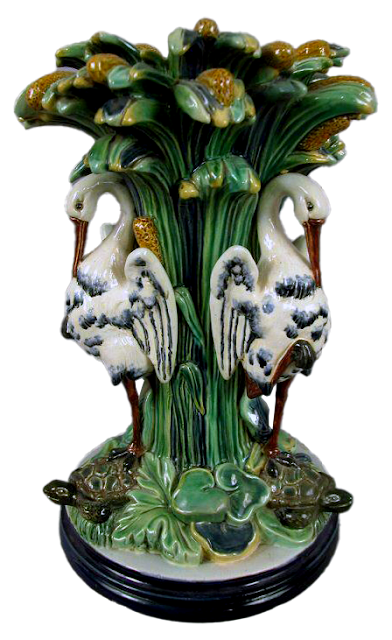The factory of Gerbing & Stephan was established in Bodenbach, Austria in 1861, today a city in the Czech Republic known as Děčín.
Friedrich Ludwig Meinulph Gerbing entered the pottery business in apprenticeship under Johann Philipp Leyhn who had a small business making siderolith pottery pipe bowls in Wermsdorf. In partnership with Wilhelm Schilller a fellow worker at Leyhn's factory, he opened a new factory in 1829 in Bodenbach—Schiller & Gerbing. In 1841 they then expanded and opened a small second location in Tetschen. Together they potted a variety of siderolith, earthenware and terra cotta utilitarian and decorative wares. After the death of Gerbing in 1848 the company continued production with Gerbing's widow Karoline until 1850 when differences with Schiller fractured the partnership and Schiller left to establish his own pottery in Obergrund. What remained of Schiller & Gerbing was inherited by Gerbing’s widow Karoline and her two children, Friedrich and Antonie.
In 1860 businessman Julius Reinhardt Stephan married Antonie Gerbing Hausschild and joined with his brother-in-law Friedrich the following year to establish the new firm of Majolikafabrik Gerbing & Stephan at the former Schiller & Gerbing pottery. Friedrich L. Gerbing remained in charge of design and production at the new plant while Stephan handled financial and business arrangements. The company specialized in decorative terracotta and faïence pottery adding majolica to their line around 1885.
In the early 1890s, Friedrich’s sons, Friedrich Alexander and Emil Alexander Gerbing took over the plant and continued the production of majolica, terracotta and faïence.
The decline of the popularity of majolica hit the company hard and the company fell into bankruptcy in 1898. It then reopened, continuing majolica production until 1903 when it finally closed. Friedrich Ludwig died two years later at the age of 77 while the Gerbing brothers went on to unrelated professions.
After 1903 the property passed through several different owners. The buildings were finally demolished in 1938.
The company used a couple of different marks on their wares. For the majority of their pottery they used variations of a G&St. impressed mark. This mark was in use from 1861-1899.
After 1900, Friedrich's sons changed the mark to F&AG, which represents the names of the two brothers. It was in use from 1900-1903
A third mark that is sometimes attributed to Gerbing is a G over the image of a bridge within a cartouche. This is incorrect, as that is actually a mark for Julius Grenier & Sohn. The mistake is easy to make because the two potteries share a similar style.



















































No comments:
Post a Comment